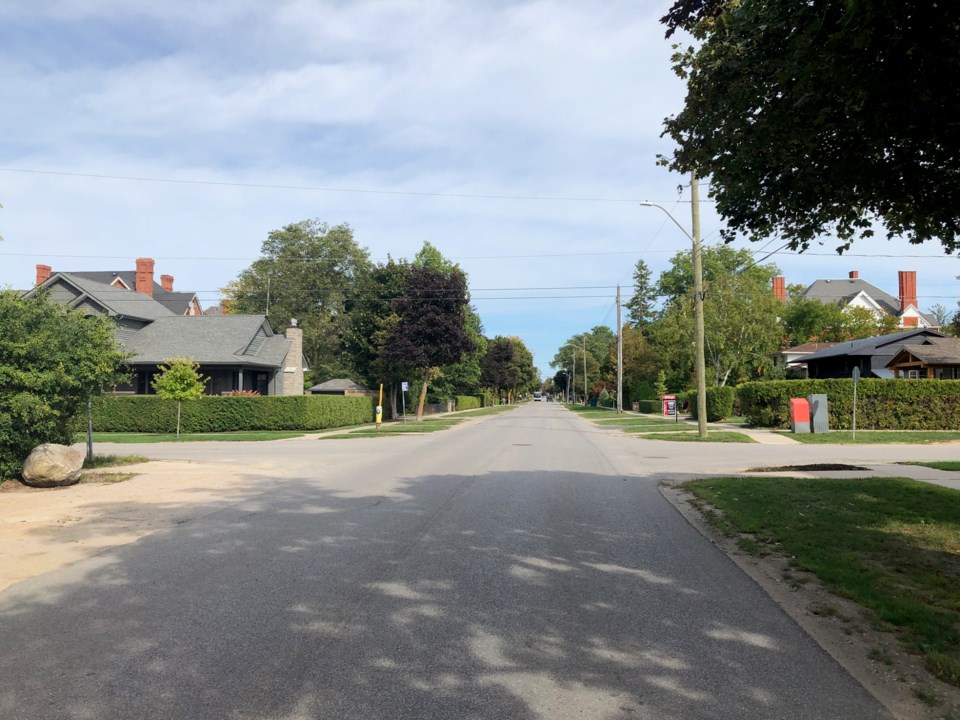Despite multiple requests by residents and an edict from a council standing committee, staff are still recommending against a stop sign at Third and Cedar Street.
A report prepared by the public works department for the Development and Operations Services Standing Committee on Monday (Sept. 23) details vehicle and pedestrian traffic studied in the area, collisions, surrounding sidewalk and crosswalk infrastructure, speed of vehicle traffic, and future plans for the site, and concludes an all-way stop is not warranted.
The report was prepared by John Velick, manager of engineering services for the town. He said the intersection was evaluated in June 2013, and October/November 2017 and staff determined no extra stops were warranted. Currently, there are stop signs on Cedar Street, but not on Third.
After further requests from residents, including deputations at public council meetings, the Development and Operations Services Standing Committee asked staff to conduct additional surveys and review of the intersection to include pedestrians and cyclists and to do so in the spring when school is in session and the weather is warm.
The report headed to committee on Monday includes data from that survey. Data was collected on May 29 and June 3, 2019, from 7 a.m. to 6 p.m. Both days were sunny with temperatures ranging from 8 Celsius in the morning to 19 Celsius in the afternoons.
Town policy states a four-way stop control may be necessary at an intersection where there is three or more right-angle turning collision per year.
While there have been three collisions at the Third and Cedar Street intersection so far this year, they have mostly been caused by someone failing to obey a stop sign.
“This could indicate that drivers are not complying due to an overabundance of stop signs in the area,” states Velick’s report.
Next, Ontario and town policy allow for an all-way stop where the volume on all intersection approaches (Third and Cedar Street) exceeds 500 vehicles per hour for eight hours of a day and the volume split between the intersecting roads exceeds 70/30 (meaning lower than 70 and higher than 30).
Based on the May and June data collection, the number of cars per hour at the intersection never exceeded 367 and the volume split since 2013 has remained stable at 80/20.
When it comes to pedestrian traffic, Velick’s report suggests an all-way stop won’t help.
“The literature surrounding an all-way stop control is clear: all-way stop controls should not be used where the protection of pedestrian, school children, in particular, is a prime concern,” states Velick. “If all-way stops are used indiscriminately, driver adherence decreases, which creates an even larger safety issue.”
Data collected in the spring shows a maximum of 120 vehicles and pedestrians at the intersection together in an hour entering from Cedar Street. The threshold for an all-way stop requires that number to be 200 or more.
In February, there were complaints from residents about vehicles speeding on Third Street. According to the data collected, about 13 per cent of the vehicles through the intersection in a week were travelling above 50 km/h, and most of those were still under 56 km/h. Less than half a per cent of the vehicles travelling through the intersection along Third Street was travelling at 65 km per hour or faster.
While the report recommends no all-way stop at the intersection, it does provide some other options for council to consider.
The town’s Development Charge Study includes a capital project to reconstruct and urbanize Third Street from High Street to Birch Street, which includes installing curbs, bike lanes, sidewalks on both sides of the street, replacing the bridge over the Oak Street canal and replacing underground infrastructure. The project is slated for 2028 and is estimated at $3 million.
With this project complete, Third Street will look much like Ontario Street.
“As part of this project, traffic calming features could also be installed,” read’s Velick’s report. “This would have to be carefully considered in relation to future traffic calming policy as there may be other roads in town with a more pressing need.”
Currently, staff is working on a traffic calming staff report to be presented to council in 2020.
Velick’s report also includes two interim options to improve pedestrian access in the area.
He suggests the town could build a temporary sidewalk on the north side of Third Street from Cedar to Spruce Street so school children can access the crossing guard at Spruce Street to cross Third.
A temporary sidewalk would cost about $75,000 and it's possible the town would have to take down trees, move hydro poles and shorten existing driveways - all work that would eventually be done in the road reconstruction in 2028. A temporary sidewalk would not be reused once the road is reconstructed.
The second interim option includes installing a school crossing and crossing guard on the west side of the Third and Cedar Street intersection. However, the town currently cannot recruit enough crossing guards for the existing school crossings in town.
The Development and Operations Standing Committee will receive the report at the Sept. 23 meeting. Members of the public are allowed to speak to the matter during the standing committee meeting, both with or without prior written notice.
The meeting begins at 5 p.m. at the town hall council chambers. You can read Velick’s full report complete with data collected here.
